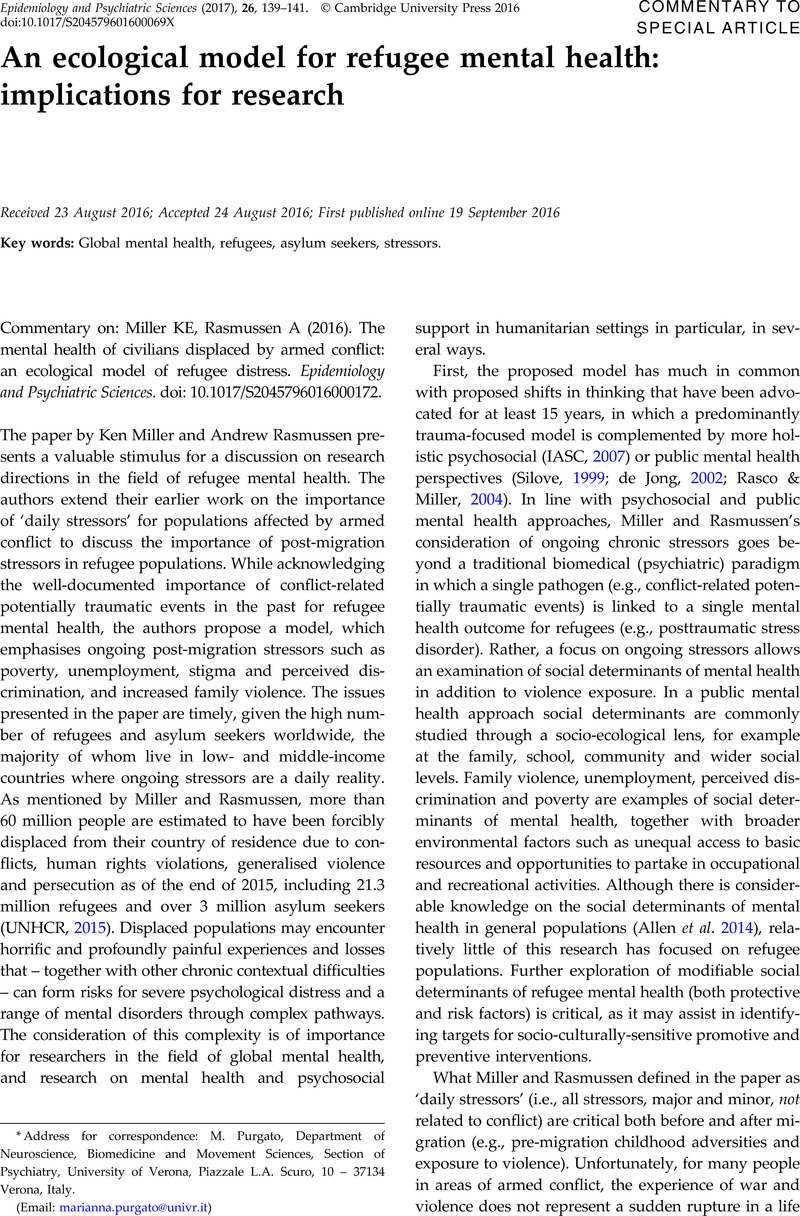Crossref Citations
This article has been cited by the following publications. This list is generated based on data provided by Crossref.
Taylor, Jessica
and
Lamaro Haintz, Greer
2018.
Influence of the social determinants of health on access to healthcare services among refugees in Australia.
Australian Journal of Primary Health,
Vol. 24,
Issue. 1,
p.
14.
Purgato, Marianna
Carswell, Kenneth
Acarturk, Ceren
Au, Teresa
Akbai, Sena
Anttila, Minna
Baumgartner, Josef
Bailey, Della
Biondi, Massimo
Bird, Martha
Churchill, Rachel
Eskici, Sevde
Hansen, Louise Juul
Heron, Paul
Ilkkursun, Zeynep
Kilian, Reinhold
Koesters, Markus
Lantta, Tella
Nosè, Michela
Ostuzzi, Giovanni
Papola, Davide
Popa, Mariana
Sijbrandij, Marit
Tarsitani, Lorenzo
Tedeschi, Federico
Turrini, Giulia
Uygun, Ersin
Välimäki, Maritta Anneli
Wancata, Johannes
White, Ross
Zanini, Elisa
Cuijpers, Pim
Barbui, Corrado
and
Van Ommeren, Mark
2019.
Effectiveness and cost-effectiveness of Self-Help Plus (SH+) for preventing mental disorders in refugees and asylum seekers in Europe and Turkey: study protocols for two randomised controlled trials.
BMJ Open,
Vol. 9,
Issue. 5,
p.
e030259.
Barbui, Corrado
Gureje, Oye
Patten, Scott B.
Puschner, Bernd
and
Thornicroft, Graham
2020.
On the need for epidemiology in psychiatric sciences.
Epidemiology and Psychiatric Sciences,
Vol. 29,
Issue. ,
Kaysen, Debra
Stappenbeck, Cynthia A.
Carroll, Haley
Fukunaga, Rena
Robinette, Katie
Dworkin, Emily R.
Murray, Sarah M.
Tol, Wietse A.
Annan, Jeannie
Bolton, Paul
and
Bass, Judith
2020.
Impact of setting insecurity on Cognitive Processing Therapy implementation and outcomes in eastern Democratic Republic of the Congo.
European Journal of Psychotraumatology,
Vol. 11,
Issue. 1,
Barbui, Corrado
Purgato, Marianna
Abdulmalik, Jibril
Acarturk, Ceren
Eaton, Julian
Gastaldon, Chiara
Gureje, Oye
Hanlon, Charlotte
Jordans, Mark
Lund, Crick
Nosè, Michela
Ostuzzi, Giovanni
Papola, Davide
Tedeschi, Federico
Tol, Wietse
Turrini, Giulia
Patel, Vikram
and
Thornicroft, Graham
2020.
Efficacy of psychosocial interventions for mental health outcomes in low-income and middle-income countries: an umbrella review.
The Lancet Psychiatry,
Vol. 7,
Issue. 2,
p.
162.
Horn, Rebecca
Arakelyan, Stella
Wurie, Haja
and
Ager, Alastair
2021.
Factors contributing to emotional distress in Sierra Leone: a socio-ecological analysis.
International Journal of Mental Health Systems,
Vol. 15,
Issue. 1,
Purgato, Marianna
Carswell, Kenneth
Tedeschi, Federico
Acarturk, Ceren
Anttila, Minna
Au, Teresa
Bajbouj, Malek
Baumgartner, Josef
Biondi, Massimo
Churchill, Rachel
Cuijpers, Pim
Koesters, Markus
Gastaldon, Chiara
Ilkkursun, Zeynep
Lantta, Tella
Nosè, Michela
Ostuzzi, Giovanni
Papola, Davide
Popa, Mariana
Roselli, Valentina
Sijbrandij, Marit
Tarsitani, Lorenzo
Turrini, Giulia
Välimäki, Maritta
Walker, Lauren
Wancata, Johannes
Zanini, Elisa
White, Ross
van Ommeren, Mark
and
Barbui, Corrado
2021.
Effectiveness of Self-Help Plus in Preventing Mental Disorders in Refugees and Asylum Seekers in Western Europe: A Multinational Randomized Controlled Trial.
Psychotherapy and Psychosomatics,
Vol. 90,
Issue. 6,
p.
403.
Soltan, Fatima
Cristofalo, Doriana
Marshall, David
Purgato, Marianna
Taddese, Henock
Vanderbloemen, Laura
Barbui, Corrado
and
Uphoff, Eleonora
2022.
Community-based interventions for improving mental health in refugee children and adolescents in high-income countries.
Cochrane Database of Systematic Reviews,
Vol. 2022,
Issue. 5,
Purgato, Marianna
Tedeschi, Federico
Turrini, Giulia
Acartürk, Ceren
Anttila, Minna
Augustinavicious, Jura
Baumgartner, Josef
Bryant, Richard
Churchill, Rachel
Ilkkursun, Zeynep
Karyotaki, Eirini
Klein, Thomas
Koesters, Markus
Lantta, Tella
Leku, Marx R.
Nosè, Michela
Ostuzzi, Giovanni
Popa, Mariana
Prina, Eleonora
Sijbrandij, Marit
Uygun, Ersin
Välimäki, Maritta
Walker, Lauren
Wancata, Johannes
White, Ross G.
Cuijpers, Pim
Tol, Wietse
and
Barbui, Corrado
2022.
Trajectories of psychosocial symptoms and wellbeing in asylum seekers and refugees exposed to traumatic events and resettled in Western Europe, Turkey, and Uganda.
European Journal of Psychotraumatology,
Vol. 13,
Issue. 2,
Jailobaeva, Kanykey
Horn, Rebecca
Arakelyan, Stella
Diaconu, Karin
Kamara, Ajaratu
and
Ager, Alastair
2022.
Social determinants of psychological distress in Sierra Leone.
Social Psychiatry and Psychiatric Epidemiology,
Vol. 57,
Issue. 9,
p.
1781.
Demazure, Gwladys
Baeyens, Céline
and
Pinsault, Nicolas
2022.
Review: Unaccompanied refugee minors’ perception of mental health services and professionals: a systematic review of qualitative studies.
Child and Adolescent Mental Health,
Vol. 27,
Issue. 3,
p.
268.
Zant, Marah Abu
Nazzal, Zaher
Qaddoumi, Layali
Abdallah, Rana
Maraqa, Beesan
and
Najjar, Khalid
2023.
Psychological morbidity among primary health care attendees in Palestine: A study in a stressful environment.
Current Psychology,
Vol. 42,
Issue. 9,
p.
7557.
Emmelkamp, Paul M. G.
2023.
Mental Health of Refugees.
p.
51.
Hertner, Laura
Stylianopoulos, Panagiotis
Heinz, Andreas
Kluge, Ulrike
Schäfer, Ingo
and
Penka, Simone
2023.
Substance (mis)use among refugees as a matter of social ecology: insights into a multi-site rapid assessment in Germany.
Conflict and Health,
Vol. 17,
Issue. 1,
L. Perocier, Vanessa
2023.
Severe Mental Illness and Family Involvement During Treatment.
The Family Journal,
Vol. 31,
Issue. 2,
p.
231.
Gettler, Lee T.
Jankovic-Rankovic, Jelena
Gengo, Rieti G.
Eick, Geeta N.
Nash, Marcela Pfaff
Arumah, Ewoton Newton
Boru, Adan Mohammed
Ali, Said Ahmed
Urlacher, Samuel S.
Meyer, Jerrold S.
Snodgrass, J. Josh
and
Oka, Rahul C.
2024.
Refugee health and physiological profiles in transitional settlements in Serbia and Kenya: Comparative evidence for effects of gender and social support.
Psychoneuroendocrinology,
Vol. 165,
Issue. ,
p.
107024.
Ruhnke, Simon A.
Hertner, Laura
Köhler, Judith
and
Kluge, Ulrike
2024.
Social ecological determinants of the mental distress among Syrian refugees in Lebanon and Turkey: A transnational perspective.
Social Science & Medicine,
Vol. 346,
Issue. ,
p.
116700.






Target article
The mental health of civilians displaced by armed conflict: an ecological model of refugee distress
Related commentaries (2)
An ecological model for refugee mental health: implications for research
The ADAPT model: bridging the gap between psychosocial and individual responses to mass violence and refugee trauma